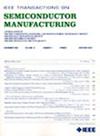Product Design Enhancement With Test Structures for Non-Contact Detection of Yield Detractors
IF 2.3
3区 工程技术
Q2 ENGINEERING, ELECTRICAL & ELECTRONIC
引用次数: 0
Abstract
Detection and monitoring of the yield loss mechanisms and defects in product chips have been a subject of extensive efforts, resulting in multiple useful Design-for-Manufacturing (DFM) and Design-for-Test (DFT) techniques. Defect inspection techniques extend optical inspection further into sub-10 nm nodes, but many buried defects are formed as a result of multi-layer 3-D interaction, and they are difficult to detect by surface optical scans. In case of a functional failure related to a defect (an open or a short), the localization of the fail site for failure analysis and root cause identification is often difficult, especially for random logic design. In this paper we describe a new -DFM methodology which inserts into the product design special test structures to support New Product Introduction (NPI) and a product yield ramp. The structures are part of PDF Solutions’ proprietary Design-for-Inspection (DFI) system with no penalty to the product layout. They are designed to be electrically tested in a non-contact way using a dedicated and specially optimized e-Beam tool. The layouts of these structures are based on the standard cell design therefore they can be used as filler cells in standard cell-based logic designs. The paper presents the concept of the test structures and their design to cover specific failure modes and enable fail mechanism identification. We describe the design flow to integrate the structures into the product floorplan and the non-contact test methodology to scan product wafers and detect failures. Finally, we demonstrate usage of such DFI structures and provide results collected from scanning product wafers containing embedded DFI filler cells.用非接触检测良率减损剂的测试结构改进产品设计
检测和监测产品芯片的良率损失机制和缺陷一直是一个广泛努力的主题,导致了多种有用的面向制造的设计(DFM)和面向测试的设计(DFT)技术。缺陷检测技术将光学检测进一步扩展到10 nm以下的节点,但许多埋藏缺陷是多层三维相互作用的结果,难以通过表面光学扫描检测到。在与缺陷相关的功能故障(打开或短路)的情况下,为故障分析和根本原因识别而定位故障位置通常是困难的,特别是对于随机逻辑设计。在本文中,我们描述了一种新的-DFM方法,该方法将特殊的测试结构插入到产品设计中,以支持新产品引入(NPI)和产品产量斜坡。这些结构是PDF Solutions专有的检查设计(DFI)系统的一部分,不会对产品布局造成任何影响。它们被设计为使用专用和专门优化的e-Beam工具以非接触方式进行电气测试。这些结构的布局基于标准单元设计,因此它们可以用作标准基于单元的逻辑设计中的填充单元。本文提出了测试结构的概念及其设计,以涵盖特定的失效模式并能够识别失效机制。我们描述了将结构集成到产品平面图中的设计流程,以及扫描产品晶圆和检测故障的非接触式测试方法。最后,我们演示了这种DFI结构的使用,并提供了扫描包含嵌入式DFI填充单元的产品晶圆收集的结果。
本文章由计算机程序翻译,如有差异,请以英文原文为准。
求助全文
约1分钟内获得全文
求助全文
来源期刊

IEEE Transactions on Semiconductor Manufacturing
工程技术-工程:电子与电气
CiteScore
5.20
自引率
11.10%
发文量
101
审稿时长
3.3 months
期刊介绍:
The IEEE Transactions on Semiconductor Manufacturing addresses the challenging problems of manufacturing complex microelectronic components, especially very large scale integrated circuits (VLSI). Manufacturing these products requires precision micropatterning, precise control of materials properties, ultraclean work environments, and complex interactions of chemical, physical, electrical and mechanical processes.
 求助内容:
求助内容: 应助结果提醒方式:
应助结果提醒方式:


